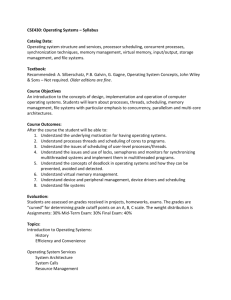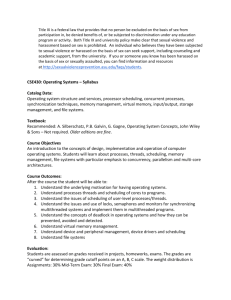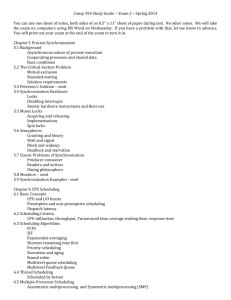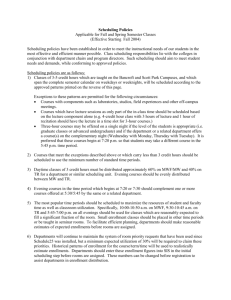IndiaStudyChannel.com Operating Systems Sixteen Marks
advertisement
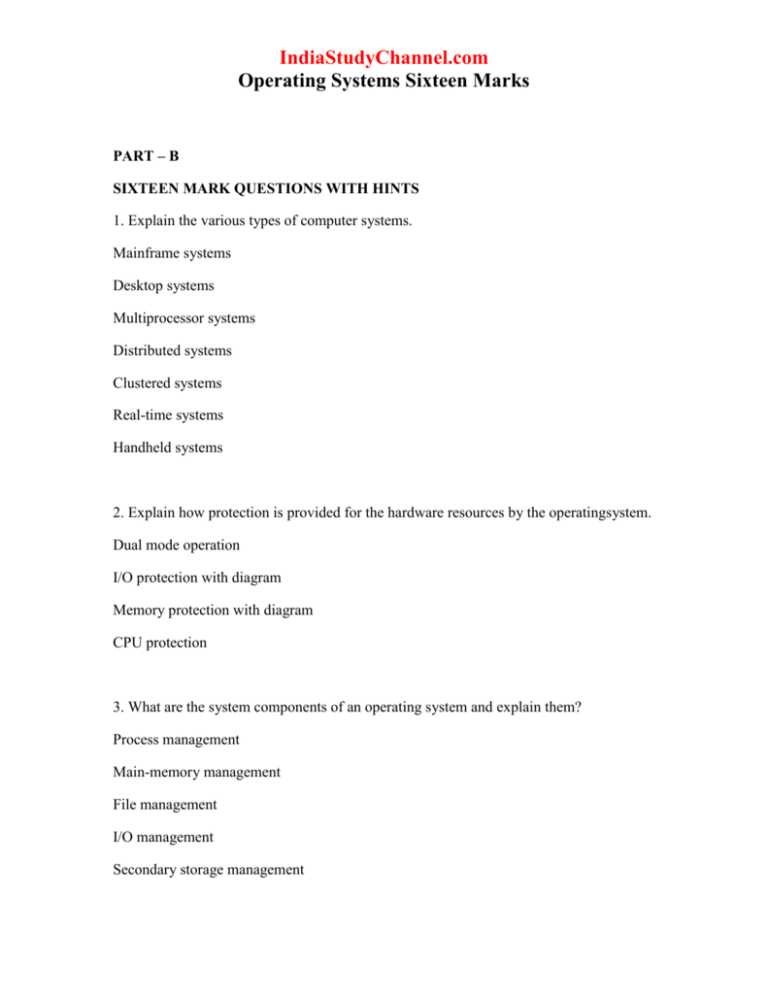
IndiaStudyChannel.com Operating Systems Sixteen Marks PART – B SIXTEEN MARK QUESTIONS WITH HINTS 1. Explain the various types of computer systems. Mainframe systems Desktop systems Multiprocessor systems Distributed systems Clustered systems Real-time systems Handheld systems 2. Explain how protection is provided for the hardware resources by the operatingsystem. Dual mode operation I/O protection with diagram Memory protection with diagram CPU protection 3. What are the system components of an operating system and explain them? Process management Main-memory management File management I/O management Secondary storage management IndiaStudyChannel.com Operating Systems Sixteen Marks Networking Protection system Command-interpreter system 4. Write about the various system calls. Process control File management Device management Information maintenance Communication 5. What are the various process scheduling concepts Scheduling queues with diagram Queueing diagram Schedulers Context switch with diagram 6. Explain about interprocess communication. Message-passing system Naming Direct communication Indirect communication Synchronization Buffering IndiaStudyChannel.com Operating Systems Sixteen Marks 7. Give an overview about threads. Thread definition Motivation Diagram Benefits User and kernel threads 8. Explain in detail about the threading issues. The fork and exec system calls Cancellation Signal handling Threads pools Thread-specific data 9. Write about the various CPU scheduling algorithms. First-come, first-served scheduling Shortest-job-first scheduling Priority Scheduling Round-robin scheduling Multilevel queue scheduling Multilevel feedback queue scheduling 10.Write notes about multiple-processor scheduling and real-time scheduling. Homogeneous systems IndiaStudyChannel.com Operating Systems Sixteen Marks Load sharing Self-scheduling Resource reservation Priority inversion Priority inheritance protocol Dispatch latency with diagram 11.What is critical section problem and explain two process solutions and multiple process solutions? Critical section problem definition Two process solutions Algorithm 1, 2 & 3 Multiple-process solution with algorithm 12.Explain what semaphores are, their usage, implementation given to avoid busy waiting and binary semaphores. Semaphore definition Usage for mutual exclusion and process synchronization Implementation to avoid spinlock using block and wakeup Binary semaphores 13.Explain the classic problems of synchronization. The bounded-buffer problem with structure The readers-writers problem with structure The dining-philosophers problem with structure IndiaStudyChannel.com Operating Systems Sixteen Marks 14.Write about critical regions and monitors. Critical region definition Implementation of the conditional-region construct Monitor definition Syntax of monitor Schematic view of monitors Monitor with condition variables Monitor solution to dining-philosopher problem 15.Give a detailed description about deadlocks and its characterization Deadlock definition Deadlock conditions Mutual exclusion Hold and wait No pre-emption Circular wait Resource allocation graph 16.Explain about the methods used to prevent deadlocks Ensure that at least one of the following does not hold Mutual exclusion Hold and wait No pre-emption Circular wait IndiaStudyChannel.com Operating Systems Sixteen Marks 17.Write in detail about deadlock avoidance. Safe state and safe sequence Diagram for safe, unsafe & deadlock states Resource-allocation graph algorithm 18.Explain the Banker's algorithm for deadlock avoidance. Deadlock avoidance definition Data structures used Safety algorithm Resource request algorithm 19.Give an account about deadlock detection. Single instance of each resource type Wait-for graph Several instances of a resource type Detection-algorithm usage 20.What are the methods involved in recovery from deadlocks? Process termination Resource pre-emption 21.Explain about contiguous memory allocation. Contiguous allocation Memory protection with diagram IndiaStudyChannel.com Operating Systems Sixteen Marks Memory allocation First fit Best fit Worst fit Fragmentation 22.Give the basic concepts about paging. Paging definition Basic method-page, frame, page table, page number & page offset Paging hardware diagram TLB with diagram Protection-protection bits & valid-invalid bits 23.Write about the techniques for structuring the page table. Hierarchical paging-two-level & multi-level with diagram Hashed page table with diagram Inverted page table with diagram 24.Explain the basic concepts of segmentation. User view of program Segmentation definition Hardware used with diagram-segment table, base, limit & offset Protection and sharing with diagram Fragmentation IndiaStudyChannel.com Operating Systems Sixteen Marks 25.What is demand paging and what is its use? Demand paging definition Virtual memory implementation Lazy swapper, page fault, pure demand paging, valid-invalid bit Diagrams 26.Explain the various page replacement strategies. Page replacement-basic scheme with diagram FIFO page replacement Optimal page replacement LRU page replacement LRU approximation page replacement Counting-based page replacement Page buffering algorithm 27.What is thrashing and explain the methods to avoid thrashing? Thrashing definition Cause of thrashing Working set model Page-fault frequency 28.What are files and explain the access methods for files? File definition Attributes, operations and types IndiaStudyChannel.com Operating Systems Sixteen Marks Sequential access with diagram Direct access Other access methods-index with diagram 29.Explain the schemes for defining the logical structure of a directory. Single level directory with diagram Two level directory with diagram Tree structured directory with diagram Acyclic-graph directory with diagram General graph directory with diagram 30.Write notes about the protection strategies provided for files. Types of access Access control list (ACL) Three classifications-owner, group & universe Other protection approaches-passwords 31.Explain the allocation methods for disk space. Contiguous allocation advantage, disadvantage & diagram Linked allocation advantage, disadvantage & diagram Indexed allocation advantage, disadvantage & diagram Performance IndiaStudyChannel.com Operating Systems Sixteen Marks 32.What are the various methods for free space management? Bit vector with example Linked list with diagram Grouping Counting 33.Write about the kernel I/O subsystem. I/O scheduling Buffering Caching Spooling & device reservation Error handling Kernel data structures 34.Explain the various disk scheduling techniques FCFS scheduling SSTF scheduling SCAN scheduling C-SCAN scheduling LOOK scheduling 35.Write notes about disk management and swap-space management. Disk formatting-low level formatting Boot block-bootstrap loader, boot block, boot disk & system disk IndiaStudyChannel.com Operating Systems Sixteen Marks Bad blocks-sector sparing, sector slipping Swap-space use Swap-space location Swap-space management

